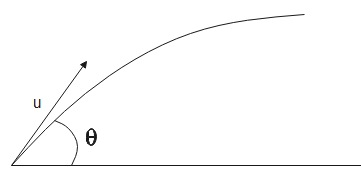Question
Question: What is the path followed by a moving body on which a constant force acts in a direction other than ...
What is the path followed by a moving body on which a constant force acts in a direction other than initial velocity (i.e. excluding parallel and antiparallel direction)?
(A). Straight lie
(B). Parabolic
(C). Circular
(D). Elliptical
Solution
The motion of a body is the resultant of one or more forces acting on it. In a projectile motion, the body has motion in horizontal as well as vertical direction. Resolving the velocity into its components and applying equation of motion, we can determine the path followed by the body
Formula used:
x=ucosθt
s=ut+21at2
Complete step-by-step solution:
According to Newton’s second law, a body undergoes acceleration when a force acts on it, therefore,
F=ma
Here, F is the force acting on a body
m is the mass of a body
a is the acceleration of the body
In a projectile, the path followed by the body is given as

Here u is the initial velocity of the body. The force acting on the body should not be parallel or anti-parallel, let ϕ be the angle between initial velocity and force, then, ϕ=0 or ϕ=180o
In a projectile no force is acting in the horizontal motion therefore, the horizontal velocity remains constant. In the vertical direction, the force of gravity acts on the body hence, the acceleration is constant. The FBD diagram of the body in projectile motion is

The force acting on the particle is mg and acceleration in the vertical direction is equal to g.
Let x be the distance covered along the horizontal axis, then
x=ucosθt - (1)
Let y be the distance covered along the vertical axis. Applying equation of motion along vertical axis we get,
s=ut+21at2
Here, s is the distance covered
t is the time taken
a is acceleration
Substituting given values in the above equation,
y=usinθt−21gt2
Substituting t from eq (1)
y=usinθucosθx−21g(ucosθx)2⇒y=xtanθ−21gu2cos2θx2
The above equation represents the equation of a parabola.
Therefore, in projectile motion, the force acting on the body is not in the direction of initial velocity and the path followed is a parabola.
Hence, the correct option is (B).
Note:
Since the force is constant, acceleration is also constant. The velocity becomes zero at the highest point of the projectile and it is maximum at the lowest point. The velocity and force are not in the same direction at any point of the projectile. The force of gravity or mg is responsible for decelerating the body.
